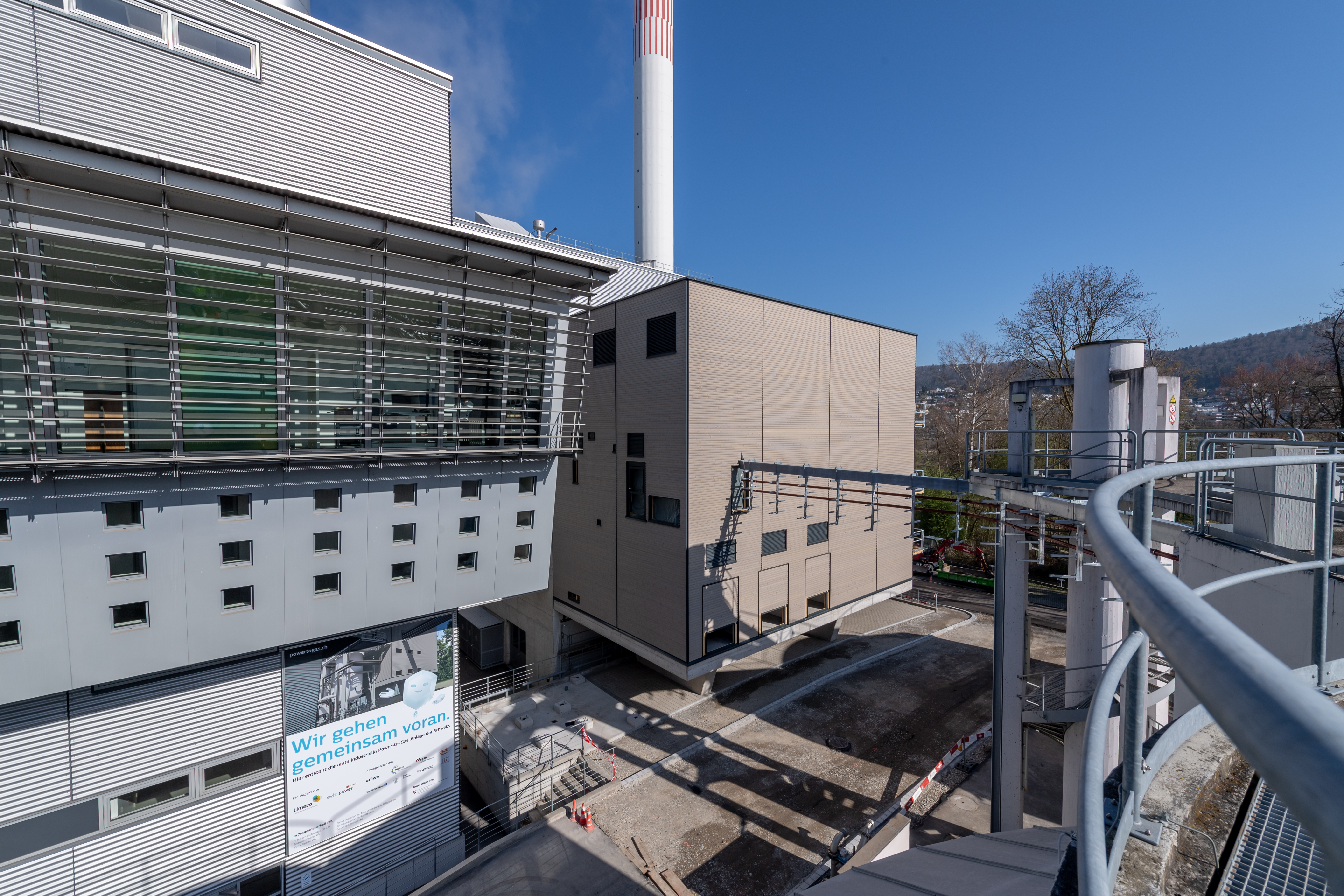"Power-to-gas" - the first industrial plant will soon go into operation
In 2022, a power-to-gas plant will go into operation in the Zurich agglomeration municipality of Dietikon. It will be the first industrial-scale project in Switzerland to feed environmentally friendly methane into the natural gas grid.

View of the power-to-gas building (center of image). © Romeo Basler / Photo Basler Aarau
What has been underway for a year in the industrial district of Dietikon in the Limmattal municipality is one of Switzerland's lighthouse projects. The power-to-gas plant, which will soon be ready for startup, will be the largest of its kind in this country and produce CO2-neutral, renewable gas.
How does the technology work?
What is needed as input electricity for the power-to-gas plant in Dietikon is in the immediate vicinity (see graphic below). Using the electricity generated from the waste incineration plant (KVA), the operators split water (H2O) into oxygen (O2) and hydrogen (H2) by means of electrolysis. Together with the sewage gas from the wastewater treatment plant (WWTP), the hydrogen is fed into the new bioreactor. Millions and millions of industrious microorganisms, so-called archaea, are active there. They produce synthetic methane (CH4) from the hydrogen and the CO2 contained in the sewage gas. Chemically, it has the same properties as natural gas. Anyone who uses it to cook, heat or operate vehicles produces carbon dioxide through the combustion process. The gas is CO2-neutral because, unlike fossil natural gas, it is part of the natural material cycle: It was only bound in plant foodstuffs for a short time and finally passed through the human digestive tract into wastewater treatment and sewage gas.

The diagram shows how power-to-gas technology works. © Limeco
Three steps for gas production
It takes three key steps for the electricity from the MWIP to produce environmentally friendly gas via the power-to-methane plant:
- Electrolysis for the production of hydrogen with the renewable part of the electricity from the MWIP
- Biological methanation for the production of synthetic methane from the CO2 in the sewage gas and hydrogen.
- Gas purification to ensure the required feed quality
Two electrolysis units with a capacity of 1.25 megawatts (MW) each are in operation in Dietikon to produce the hydrogen. This will be the largest power-to-gas plant in Switzerland, according to Limeco. The Limmattal regional plant aims to use it to produce 18 gigawatt hours of renewable gas per year. "By replacing fossil natural gas, we can save up to 5000 tons of CO2 emissions per year," says Thomas Di Lorenzo of Limeco. This would substitute the annual CO2 emissions of around 2000 households.
Financing via certificates
The financing model is also special about this project. According to Di Lorenzo, the 14-million-franc plant is being financed by eight Swiss energy providers from Aarau, the Linth region, Bern, St.Gallen, Dietikon, Schlieren, Lenzburg and Interlaken. The energy service providers would sell the ecological benefit of the environmentally friendly produced gas to their end customers via certificates. Di Lorenzo adds: "Because the electricity is drawn directly from the waste incineration plant, there are no grid usage fees for them as operators. This halves the cost of converting the electricity into hydrogen (electrolysis). This is an important factor for the industrial operation of such a plant, Di Lorenzo said at the first power-to-gas congress in September 2021 in the Umwelt Arena in Spreitenbach.
Provide grid-stabilizing control energy
With this project, Limeco wants to prove that it is technologically and economically possible to operate a power-to-gas plant. This is a central technology that can be used to make the electricity fed into the grid by a MWIP more flexible: MWIP operators can thus feed electricity directly into the grid when it is needed. If, on the other hand, other power plants produce enough or even too much electricity - for example, solar plants in the summer - green and storable gas is to be produced from the MWIP electricity using power-to-gas technology. By operating the power-to-gas plant flexibly, Limeco can also provide grid-stabilizing balancing power - a system-serving service that is financially compensated.
Potential for wastewater treatment plants and MWIP
If the power-to-gas concept proves successful in Dietikon, it holds great potential: power-to-gas plants at Switzerland's 100 largest wastewater treatment plants alone could meet the energy needs of more than 250,000 people, i.e. several medium-sized Swiss cities. MSWIs could also be equipped with such plants, making an important contribution to balancing seasonally fluctuating electricity production: according to Limeco, power-to-gas plants allow utilities to store electricity in the form of gas during the summer months. This energy would be fed into the grid as electricity and into the district heating network as heat in the high-demand winter by means of combined heat and power.
For more information on the power-to-gas plant in Dietikon: www.powertogas.ch
Convert surplus electricity into gas
The more photovoltaics is expanded, the higher the electricity production in summer. During this time, however, the economy and society only need part of this energy. An Empa analysis of the potential of power-to-gas technology - i.e. the conversion of renewable electricity into chemical energy carriers such as hydrogen or methane - assumes around ten terawatt hours (TWh) of surplus renewable electricity in the coming decades. This assumes that around half of Switzerland's suitable roof surfaces are equipped with photovoltaics. This surplus electricity could be used to produce around five TWh of synthetic gas via power-to-gas.
In this way, the surplus green electricity would contribute to the stability and efficiency of the overall system. The conversion of renewable electricity into seasonally storable energy sources is an important pillar of a decarbonized energy system, says Empa researcher Martin Rüdisüli.
The contribution "Power-to-gas" - the first industrial plant will soon go into operation first appeared on Environment perspectives.









